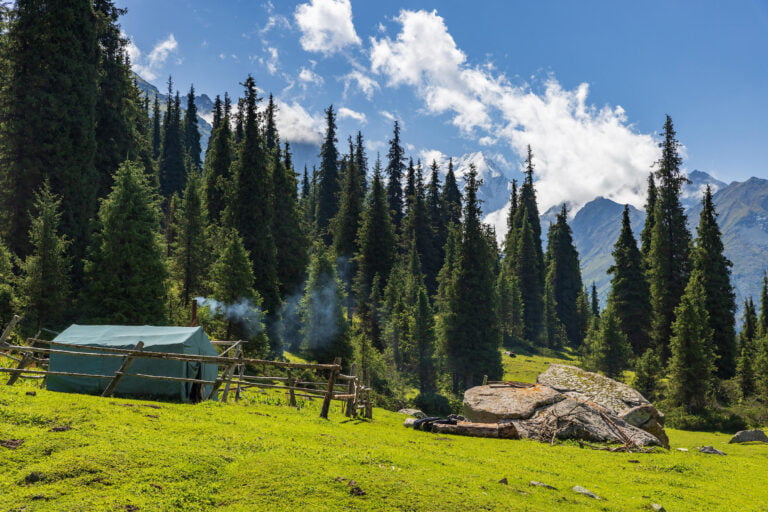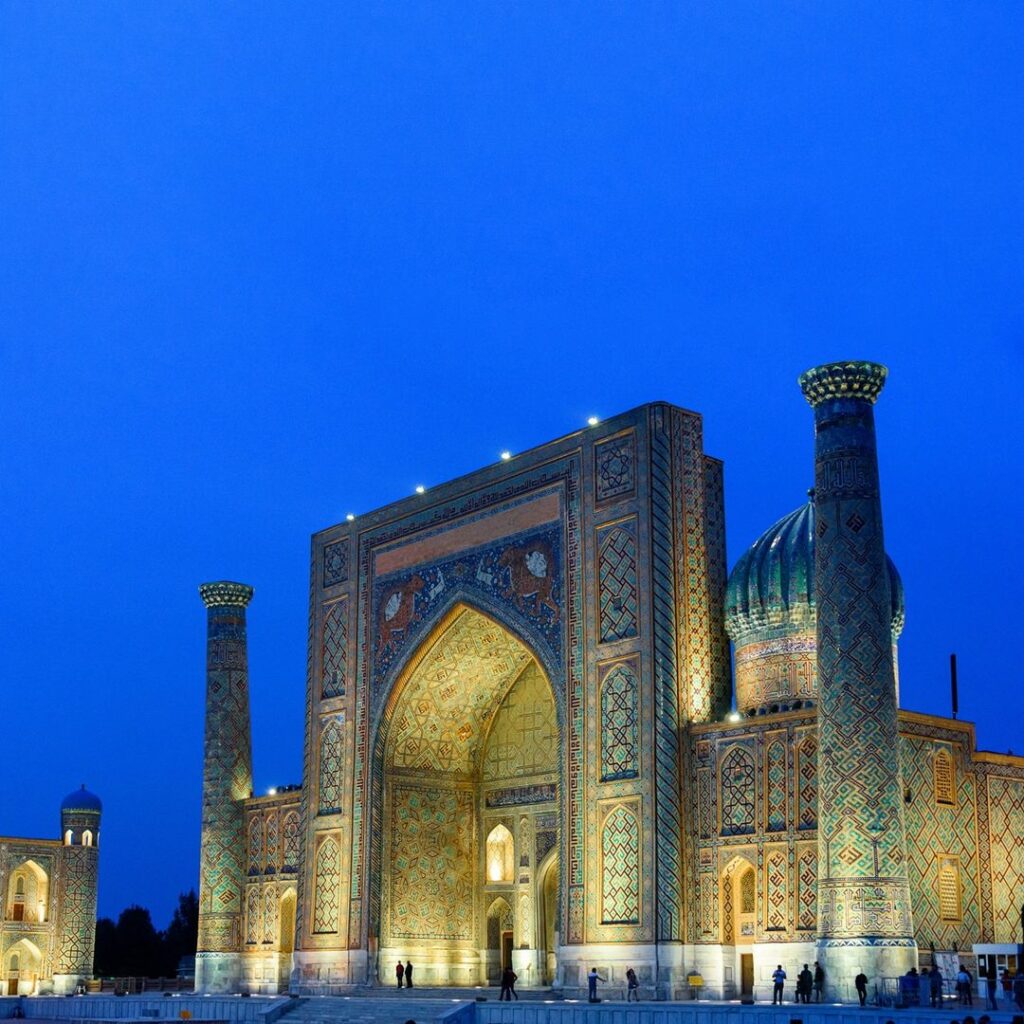

Samarkand
The name Samarkand is derived from Old Persian asmara (“stone, rock” and from Sogdian qand (“fort”, “town”). Samarkand literally means “stone fort” or “rock town”). Samarkand had a central position on the Silk Road between China and the West. In the 14th century Temur (Tamerlane) made Samarkand the capital of his empire. Samarkand is a must see for all travellers visiting the Central Asia. It was added to the UNESCO World Heritage List in 2001 as Samarkand
By train
There are daily trains from Tashkent, the morning train No. 2 departs every day at 07:00 except Tuesday and Wednesday arriving three hours later at 10:50. Train No. 4 is an evening train and departs all days except Wednesday at 18:20 arriving 21:55. The slower 662 bound for Bukhara departs daily at 20:45, arriving 02:11.
The most popular international route is from Saint Petersburg (93h) via Volgograd (57h) departing every Friday at 07:30 arriving five nights later at 06:26. This train bypasses Moscow, nearest stop is in the town of Ozherelye. There is also a weekly connection from Almaty departing every Sunday at 15:50 arriving 07:59 two nights later.
Buses No 3 and 73 run from the train station (vokzal) to Registan and beyond and cost 1200 som, payable to the driver when exiting the bus (as of June 2018). Taxi to anywhere near Registan area should not cost more than 10000-15000 som (June 2017) even if they quote you higher prices and argue that it is “very far”.
By road
Samarkand is about 4 hours by road from Tashkent; shared taxis leave from Sobir Rahimov bus station.
The distance to Samarkand from Tashkent is 290km, from Bokhara 270km, from Khiva 740km, from Andizhan 610km, from Fergana 600km, from Karshi 150km, from Kokand 500km, from Nukus 820km, from Shahrisabz 90km, from Termez 380km and from Urgench 700km.
See
Gur-Emir
Note: As at October 2019 all prices appear to be rapidly increasing in UZS, partially due to inflation, but in some cases to real price increases. Still cheap by international standards, but can add up over a day if you see all the sights to nearly UZS200k per person (USD20), at approximately UZS25k per site (some are slightly cheaper, Registan is more). Make sure you’ve got cash at hand.
- Registan Ensemble. Registan became the city square when the life in Afrosiab stopped. Since that time Registan was reconstructed several times. Today it is surrounded by the three medreses Ulugbek, Shirdor and Tilla Kari. UZS40,000.
- Shirdor Medrese, (on Registan, opposite Ulugbek medrese). Medrese Shirdor repeats the facade and composition of Ulugbek medrese opposite. In Shirdor medrese the first floor is preserved, whereseas it is destroyed in Ulugbek medrese. The decorations of entrance portal are illustrating the tiger (“shir” that’s why it is called Shirdor. Ornaments and decorations are very rich, but its quality is worse than of Ulugbek medrese. Shirdor medrese was erected by order of Uzbek feudal lord Yalangtush in 1619-1632. Inscriptions of medrese show the names of the masters Abdaldjabbar and Muhammad-Abbas.
- Ulugbek Medrese, (on the western side of Registan Square). The oldest medrese on Registan is a large rectangular building with monumental portal and a yard with four-verandahs, surrounded by cells for students and with four classrooms in the corners. In the western part is a winter mosque. The corners of the building are decorated with high minarets. The decorations consists of glazed and unglazed bricks, mosaics, majolica,carving marble. The most beautiful decorations are zhose of the main portal, where geometric, vegetative and epigraphic decorations were used. Inscriptions mention Ulugbek and several dates relating to the stages of construction. In 823 (1420) when the construction of the medrasah was finished.
- Tilla Kari Medrese.
- Gur Emir Mausoleum (Gur-e Amir Mausoleum), Akhunbabayev. 8-19. (aka Amir Temur Mausoeum) As a conqueror there are few that are Tamerlane equal, both in territory and lives taken. It is said that he made pyramids out of the skulls of his vanquished. Today one can visit his tomb in the beautifully reconstructed Gur-Emir Mausoleum (1404-1405, 15-17 centuries) and reflect on his life while looking at the largest piece of jade (greenstone) in the world. [Oct 2019] entrance UZS25,000.
- Bibi-Khanym Mosque, Tashkent kochasi (on the pedestrian by Siob Bazaar). The restored Mosque Bibi-Khonym (named after the wife of Temur 1399-1404) is one of best known architectural attractions of Central Asia. The Mosque was erected on Timur’s order after his raid of Delhi. The Minaret of the Mosque was supposed to be the tallest. [Aug 2012] UZS 20,000.
- Shakhi-Zinda Ensemble. Another point of interest is ancient necropolis Shakh-i-Zinda (9-14, 19 centuries)situated on southeastern mound of Afrosiab. This architectural complex consists of 44 tombs in more than 20 mausoleums. The greatest Significance of Shah E Zinda is that he was the First cousin of the Prophet Muhammad PBUH and resembles the Prophet the most. (Hadrat Hissam Ibne Abbass or Kissam Ibne Abbass) {GPS N 39.39.42.4 , E 066.59.16.5} UZS 25,000.
- Afrosiab, Tashkent kochasi (on an irrigated valley of the Zerafshan River, a few hundred meters from the center of the city). The ruined site of ancient and medieval Samarqand in the northern part of the modern town. This place always ensured favorable conditions for human settlements. As proof, one can freely walk through the ancient ruins. A museum is in the center of the remains. The famous Persian Pehlvan Rustam and Sohrab belonged to the Afrosiyob. UZS25,000.
- Khazrat-Khizr, Tashkent kuchasi. 8-18. This mosque is one of the ancient edifices of Samarkand was destroyed by Genghis Khan’s hordes. It was rebuilt in 19 cent. A beautiful Mosque stands on the elevation at the entrance of town from where their eye wanders over Bibi-Khonym Mosque, the big bazaar and the mountains in the South.
- Tomb of Prophet Daniel, Afrosiab (Off Tashkent Kochasi, Northeast of Registan). Amongst other curiosities in Samarkand is the tomb of the Hebrew Prophet Daniel, which is in the cemetery section of Afrosiab next to a pleasant stream. For a small fee you may enter the tomb, which contains a burial chamber around 18 meters long. Muslim men will offer prayers while you listen respectfully. After the conquest of Syria the grave was transported to Samarkand under the orders of Amir Temur.
- Ulugbek’s Observatory, approx 1km up the road from Afrosiab (Off Tashkent Kochasi, Northeast of Registan). Another curiosity is the observatory of Ulugbek (Timur’s grandson). It was located by the Russian archeologists. Only the foundations remain but it is truly extraordinary. Ulugbek was an astronomer, scientist and architect. His scientific and astronomical discoveries greatly advanced knowledge in these fields. The monument is situated in the north-east outskirts of city at the foot Chupan-ata mountain, which in medieval times was called Kukhak. That was three floor round building, decorated by glazed tiles, majolica, mosaic, but it was destroyed. The only thing that was preserved is a part of huge sextant – major astronomic instrument, the lowest part of which was in a deep trench (11km). Both arcs of this instrument are made of marble with indication of degrees. During the excavation works there were found a lot of remains of other astronomic instruments. Even being preserved partially, the observatory of Ulugbek is unique not only for Central Asia, but also for the whole world. The remains of observatory were conserved at the beginning of 60s XX. Here was also organized museum, where collecting the unique astronomic information and instruments related to Timurids epoch. UZS25,000.
- The Mausoleum of Al Buxori Al Bukhari located in a suburb of Samarkand, at Payerik. Al Buxori was collector of the sayings of prophet Muhamed and compiled them in to a book Known as Hadith Bukhari Sharif or Bukhari Sahih. He was buried in the place where his mausoleum is located now. His Mausoleum was reconstructed by Uzbek Government and supported by some Muslim Governments, the bricks were delivered from Saudi Arabia and Kuwait. The project was financed by the Iranian government. The constructers and artists from all Uzbekistan and Iran were working to reonstruct the complex. The Green Marble was supplied by the Pakistan Government. According to newspaper articles Imam Bukhari’s grave is visited every day by about 1.000 visitors from all over the world. The present building was constructed on top of the original grave of Imam Al-Bukhari in 1997, 1225 years after the imam’s death. The complex consists of Al Bukhari’s mosque and grave and a museum exhibiting Qurans from some Muslim countries.
- Abu Mansoor Al Matrudi Mausoleum Newly Renovated the Mausoleum of great Sunni Faqi is located 1 Km from masjid Bibi Khanum inside the Residential area. Visitor has to walk. Mirza Zaheer Ud Din Babur in his book Babur Noma has praised the knowledge and Command on Fiqah of Abu Mansoor Al Matrudi.
- Rukhabat Mausoleum, Akhunbabayev (between Registan square and Gur-Emir ensemble). This is a central square mausoleum without portal with four identical facades. The arch entrance is decorated by blue glazed tiles and eventually the cupola was also covered by glazed tiles. According to manuscripts Rukhabat mausoleum (“place of spirit presence”) was the burial place of the Samarkand sufi Burkhan ad-Din Sagardji, who died in 1380s. The mausoleum was built at a time, when central compositions were not popular and decorations of burial architecture was very rich. On the occasion of anniversary of Amir Timur in 1996 all buildings, which were not related to the monument, were destroyed and the ruins of constructions of Rukhabat complex – the mosque, khidjras, medrese and minaret came to light. Lonely Planet recommends to not pay the steep entrance fee
- Abdi Darun Ensemble, (in the north-east part of city). The mausoleum was erected over the grave of famous lawyer. It has been reconstructed for several times. A ‘ziaratkhana’ was built in front of mausoleum during the reign of Ulugbek. The portal and cupola drum are decorated with geometric ornaments and inscriptions from glazed bricks. In the cemetery are ‘dahmas’ (large grave constructions), dating to the 15 cent., covered with glazed tiles. The mosque was constructed at the beginning of 20 cent. It consists of a winter room and a summer column aivan, decorated by pottery carving and colored paintings. A small medrese was added at the end of 19th cent.
- Ishrat-khana Mausoleum, Sadriddin Ayniy. Ruined and atmospheric with no people at all {GPS N 39.38.35.0 , E 066.59.26.5} [Aug 2012] free.
- Ak-Saray Mausoleum.
- Khodja Ahrar Ensemble, (in the northern part of city near the cemetery). The grave of the famous religious and state benefactor of 15th cent. Nakshbandi Ubeidallah Ahrar is decorated by white marble tiles covered by inscriptions. The Medrese of Nadira divan-begi is a one floor building with a traditional four-aivans yard composition. The main entrance is decorated by portal, two khudjras are situated on the both sides of it as well as in the north and south parts of building. The western part of building is a mosque with a huge portal, main hall (mikhrab) and four rooms. The mosque was probably built in 15th cenr., but the medrese was erected in 1040-1045 (1630-1636) according to the order of well-known official Nadira divan-begi by architect Dust-Mukhammad. The decoration are very typical for ?VII: majolica, mosaic of high quality. The decorations of entrance portal are illustrating tigers and does. The summer mosque was built in XVII in the south from medrese. The decorations of mikhrab niche of this mosque are very similar to medrese. The column aivan (verandah) between medrese and summer mosque was constructed or reconstructed in later period. At the beginning of XX century ceiling of aivan was covered by vivid paintings. A small minaret, which is situated opposite to aivan, was erected in 1909 by Sadulla architect.

